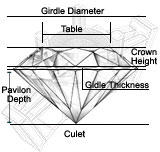LEARN ABOUT DIAMONDS
INTRODUCTION TO DIAMOND EDUCATION
A BRIEF HISTORY OF DIAMONDS
Diamonds are some of the most sought after gems in the whole world, believed to be a symbol of love, beauty, and purity. Believed to have been discovered first in India, diamonds weren’t used for jewelry until 1074, when a Hungarian queen’s crown was decorated with them. After that, the diamond was used for jewelry often, but it didn’t become popular for the engagement ring until the first diamond engagement ring was given to Mary of Burgundy by the Archduke Maximilian of Austria in 1477. After that, different cuts were discovered for diamonds and the diamond engagement ring became what we know today.
THE 4 C’S
Diamonds are graded on a scale to determine their worth, with a high quality diamond having all of the 4 C’s, which are cut, color, clarity, and carat.
- Cut
The cut of a diamond is one of the most important things about a diamond. Without a proper cut, a diamond won’t shine or sparkle quite like it should. With a proper cut, the diamond can create three different optical effects: brightness, which appears as a white light, fire, which is the flashes of color, and scintillation, which are bright and dark areas in the diamond itself. There are many different types of cuts that will create a bright diamond, and some cuts are preferred over other cuts. The standard cut is a round brilliant cut, with many other cuts from the marquise cut, the princess cut, the pear cut, the oval cut, the heart cut, and the emerald cut.
- Color
Next, the color of a diamond is graded on a scale from D to Z, starting from colorless, and ending at a light color. Most often, people will purchase in the D to J range which is the colorless and near colorless range, but some people will look from the K to Z range, which will offer a much better price.
- Clarity
Clarity is the perfection of a diamond. Most diamonds are never perfect, and can have anything from scratches to nicks, and trapped substances, like minerals or smaller diamonds trapped inside. The clearer the diamond, the more expensive it is. But, with most diamonds, unless you can see the imperfection by eye, it won’t matter too much if you have imperfections in your diamond.
- Carat
Lastly, the carat of the diamond is the last C, which is the size of the diamond, and can be anywhere from a fraction of a carat to a 10-carat diamond. Depending on whether the cut is good, the color is colorless, and the clarity is high, a smaller carat can be worth more than a larger carat.
THE UNIQUENESS OF DIAMONDS
Overall, diamonds are extremely unique rocks that come in many different shapes, colors, and sizes. No matter what size of loose diamond you need, or whether you are looking for a men’s ring or an engagement ring in Michigan, Azzi Jewelers can help you with whatever you need.

DIAMOND HISTORY
Across time and cultures diamonds are a consistent expression of luxury. Diamonds symbolize wealth, durability, and status. Conversely, they have the rich history of being associated with invulnerability, lightning, magic, healing, protection, and poisoning. In unraveling the history and associations of diamonds, we need to look through time and at their very origins to gain a historical perspective of their tremendous value.
"Diamond" comes from the Greek adamao, transliterated as "adamao," "I tame" or "I subdue." The adjective "adamas" was used to describe the hardest substance known, and eventually became synonymous with diamond. It is difficult to determine at what point in history the hardest known substance became diamond.
Diamonds began to appear in European regalia and jewelry in the 13th century. By the 16th century the diamonds become larger and more prominent, as a result of the development of diamond faceting – a technique that enhances the diamonds brilliance.
By the 17th Century, Diamonds dominated the small jewels and large ones became adornments by the 18th century.
Kings rule – the act of Saint Louis (Louis IX of France, 1214-70) established a sumptuary law reserving diamonds for the king. This bespeaks the rarity of diamonds and the value conferred upon them.
Over the next century diamonds appeared in royal jewelry, then among the greater European aristocracy, with the wealthy merchant class showing the occasional diamond by the 17th century.
The earliest European ornamental and regal applications feature diamond points that resemble the Roman style of natural points in rings. Unlike the Roman examples, the European points may have been polished, if only to remove surface irregularities and coatings of any foreign mineral.
The taboo on modifying a diamond crystal into a gem, which originated in India, ends around this time in both Europe and India. There is no recorded explanation, but the implications of the rise of diamond's popularity in ornamentation are nothing short of revolutionary -- as more diamonds reach Europe, demand for the brilliant gem increases.
The earliest diamond-cutting industry is believed to have been in Venice, a trade capital, starting sometime after 1330. Diamond cutting may have arrived in Paris by the late 14th century; for Bruges -- on the diamond trade route -- there is documentation for the technique in 1465.
DIAMOND CONVERSION CHART
| Diamond Conversion Chart |
|---|
| .09 to .13 is a 1/10th |
| .14 to .17 is a 1/6th |
| .18 to .23 is a 1/5th |
| .24 to .28 is a 1/4 |
| .29 to .34 is 1/3 |
| .35 to .44 is 3/8 |
| .45 to .55 is a 1/2 |
| .56 to .65 5/8 |
| .66 to .72 is 7/10 |
| .73 to .78 is 3/4 |
| .79 to .86 is 8/10 |
| .87 to .95 is 7/8 |
| .96 to 1.05 is 1 ct |
